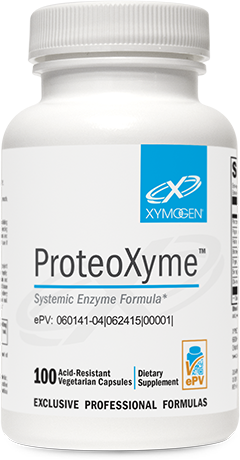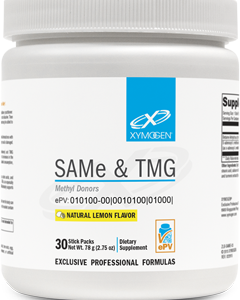Scientific Information/Data
Enzymes are complex proteins that catalyze metabolic reactions throughout the body, and sufficient levels are necessary for optimizing many bodily functions. Though the body naturally produces its own supply of enzymes, production can vary with age and biochemical individuality.*[1]
Proteolytic enzymes, also known as proteases, specifically break down proteins into peptides and amino acids through the process of “proteolysis.” For example, proteases produced by the pancreas assist in the digestion of dietary protein. Some proteases, such as trypsin, are then resorbed, transported in the bloodstream, and resecreted by the pancreas. Enzymes in circulation are bound to antiprotease alpha-2-macroglobulin to protect them from being degraded by other serum proteases and to retain their enzymatic activity.*
ProteoXyme™ is a proteolytic enzyme formula designed to be absorbed across the gastrointestinal mucosa and into circulation.[2] When distributed systemically, proteolytic enzymes can break down proteins and complexes generated during injury and tissue damage. This action supports the body’s normal recovery process.*
In vivo studies suggest that trypsin and other proteases, though normally confined to the bloodstream, are able to enter the site of injury.[3] At this site, they are able to support immune function and affect cytokine production. Research suggests that orally administered proteolytic enzymes may exert this beneficial effect as well.[3,4] It is thought that they function as proteinase-activated receptor (PAR) modulators, a feature which allows them to contribute to immune and cytokine balance.[5] Proteolysis of intestinal microorganisms may contribute to the immunostimulatory effects of oral proteolytic enzymes as well.*[6]
Proteolytic enzymes have been used worldwide for decades to support health and healing. For example, research on bromelain (an enzyme obtained from pineapple) suggests that it positively affects eicosanoid production and balance.[7-9] Furthermore, it is suggested that bromelain supports the body’s innate and adaptive immune function,[10,11] signifying an effect beyond that of proteolysis in some cases.*
Serrapeptase (also known as serratiopeptidase) is an enzyme produced by microorganisms in the gastrointestinal tract of silkworms. Silkworms use it to digest their cocoons. Multicenter, double-blind studies suggest that serrapeptase significantly supports tissue integrity and comfort and is well-tolerated.[12,13] Pancreatin in ProteoXyme™ is a mixture of pancreatic enzymes containing chymotrypsin, trypsin, amylase, and lipase. The papain present is a proteolytic enzyme derived from papaya fruit.*
The effect of combining various proteolytic enzymes has been studied closely for decades. For example, the combination of trypsin and chymotrypsin has a history of use in the support of tissue integrity and healing, with positive results in early double-blind trials.[14-16] The combination of bromelain, trypsin, and rutin has been researched and found to produce positive results as well.[17] For example, in a six-week, randomized, double-blind, parallel group trial (n=90), oral proteolytic enzymes were well-tolerated and positively affected clinical outcomes, including Western Ontario and McMaster Universities osteoarthritis index (WOMAC) and Lequesne’s index scores, as efficiently as other compounds studied.[18] Another randomized double-blind controlled study using systemic enzyme therapy (a combination of bromelain, trypsin, and rutin) reported “remarkable differences” in tissue comfort and integrity in subjects who received the enzyme therapy.*[19]
ProteoXyme™ contains a combination of pancreatin, papain, rutin, bromelain, trypsin, chymotrypsin, and serrapeptase in acid-resistant capsules that are designed to withstand gastric juices, ultimately allowing direct absorption into the bloodstream. For best results, the formula should be consumed on an empty stomach.*
*These statements have not been evaluated by the Food and Drug Administration. This product is not intended to diagnose, treat, cure, or prevent any disease.
References
- Paczek L, Michalska W, Bartlomiejczyk I. Trypsin, elastase, plasmin and MMP-9 activity in the serum during the human ageing process. Age Ageing. 2008 May;37(3):318-23. [PMID: 18332058]
- Castell JV, Friedrich G, Kuhn CS, et al. Intestinal absorption of undegraded proteins in men: presence of bromelain in plasma after oral intake. Am J Physiol. 1997 Jul;273(1 Pt 1):G139-46. [PMID: 9252520]
- Lehmann PV. Immunomodulation by proteolytic enzymes. Nephrol Dial Transplant. 1996 Jun;11(6):952-5. [PMID: 8671947]
- Shahid S. Role of systemic enzymes in infections. WebmedCentral COMPLEMENTARY MEDICINE 2011;2(11):WMC002495. http://www. webmedcentral.com/article_view/2495. Accessed October 4, 2012.
- Steinhoff M, Buddenkotte J, Shpacovitch V, et al. Proteinase-activated receptors: transducers of proteinase-mediated signaling in inflammation and immune response. Endocr Rev. 2005 Feb;26(1):1-43. [PMID: 15689571]
- Biziulevicius GA. Where do the immunostimulatory effects of oral proteolytic enzymes (‘systemic enzyme therapy’) come from? Microbial proteolysis as a possible starting point. Med Hypotheses. 2006;67(6):1386-8. [PMID: 16870353]
- Kelly GS. Bromelain: A Literature Review and Discussion of its Therapeutic Applications. Alt Med Rev. 1996;1(4): 243-57. [copy on file].
- Wallace JM. Nutritional and botanical modulation of the inflammatory cascade—eicosanoids, cyclooxygenases, and lipoxygenases—as an adjunct in cancer therapy. Integr Cancer Ther. 2002 Mar;1(1):7-37; discussion 37. Review. [PMID: 14664746].
- Taussig SJ, Batkin S. Bromelain, the enzyme complex of pineapple (Ananas comosus) and its clinical application. An update. J Ethnopharmacol. 1988 Feb-Mar;22(2):191-203. [PMID: 3287010]
- Barth H, Guseo A, Klein R. In vitro study on the immunological effect of bromelain and trypsin on mononuclear cells from humans. Eur J Med Res. 2005 Aug 17;10(8):325-31. [PMID: 16131473]
- Maurer HR. Bromelain: biochemistry, pharmacology and medical use. Cell Mol Life Sci. 2001 Aug;58(9): 1234-45. [PMID: 11577981]
- Tachibana M, Mizukoshi O, Harada Y, et al. A multi-centre, double-blind study of serrapeptase versus placebo in post-antrotomy buccal swelling. Pharmatherapeutica. 1984;3(8):526-30. [PMID: 6366808]
- Mazzone A, Catalani M, Costanzo M, et al. Evaluation of Serratia peptidase in acute or chronic inflammation of otorhinolaryngology pathology: a multicentre, double-blind, randomized trial versus placebo. J Int Med Res. 1990 Sep-Oct;18(5):379-88. [PMID: 2257960]
- Deitrick RE. Oral proteolytic enzymes in the treatment of athletic injuries: A double-blind study. Pa Med. 1965 Oct;68(10):35–7. [PMID: 5318158]
- Rathgeber WF. The use of proteolytic enzymes (Chymoral) in sporting injuries. S Afr Med J. 1971 Feb 13;45(7):181–3. [PMID: 4928685]
- Buck JE, Phillips N. Trial of Chymoral in professional footballers. Br J Clin Pract. 1970 Sept;24(9):375–7. [PMID: 4918726]
- Akhtar NM, Naseer R, Farooqi AZ, et al. Oral enzyme combination versus diclofenac in the treatment of osteoarthritis of the knee—a double-blind prospective randomized study. Clin Rheumatol. 2004 Oct;23(5):410-5. [PMID: 15278753]
- Klein G. Efficacy and tolerance of an oral enzyme combination in painful osteoarthritis of the hip. A double-blind, randomized study comparing oral enzymes with non-steroidal anti-inflammatory drugs. Clin Exp Rheumatol. 2006 Jan-Feb;24(1):25-30. [PMID: 16539815]
- Kamenícek V, Holán P, Franĕk P. Systemic enzyme therapy in the treatment and prevention of post-traumatic and postoperative swelling [in Czech]. Acta Chir Orthop Traumatol Cech. 2001;68(1):45-9. [PMID: 11706714]






